Thanks, dcgold, this is quite interesting.
(1) If I’m interpreting your chart correctly, in a downward firing position, that driver emits a roughly flat response from the back, over 360 degrees up to about 10KHz. Is that correct?
(2) Is the variance in response amplitude from the back about the same as from the front when the driver is conventionally positioned, or is it worse?
(3) Can I safely presume that the 10KHz response knee mirrors another 10KHz knee from the front axis of the driver when it’s conventionally positioned? In other words, is it simply due to the high freq. roll-off seen from the front axis of the driver?
Thanks
(1) If I’m interpreting your chart correctly, in a downward firing position, that driver emits a roughly flat response from the back, over 360 degrees up to about 10KHz. Is that correct?
(2) Is the variance in response amplitude from the back about the same as from the front when the driver is conventionally positioned, or is it worse?
(3) Can I safely presume that the 10KHz response knee mirrors another 10KHz knee from the front axis of the driver when it’s conventionally positioned? In other words, is it simply due to the high freq. roll-off seen from the front axis of the driver?
Thanks
Last edited:
I'd rather see a polar plot, from 0° on axis (directly above) to 90° off axis (horizontal), as it is going to be used in a presumably sealed enclosure.
Hi Ken, I will measure from the front so you have a comparison.
Hi ripblade, I can measure from a few different angles, but nothing so sophisticated as a polar response. The response was 90 degrees off axis.
It might take a few days to get to it, have business and weekend plans.
Hi ripblade, I can measure from a few different angles, but nothing so sophisticated as a polar response. The response was 90 degrees off axis.
It might take a few days to get to it, have business and weekend plans.
Thanks for participating, David. It's always nice to have manufacturers involved in the discussion.
Yes, a polar plot would be best, but, as dcgold alludes, that is much mored involved to produce. His offer to plot the response at a few horizontal angles around the cone should still prove quite informative.I'd rather see a polar plot, from 0° on axis (directly above) to 90° off axis (horizontal), as it is going to be used in a presumably sealed enclosure.
Why, the presumption that it’s going to be used in a sealed box?
Last edited:
You mentioned Ohm Walsh in your OP. I assumed that was how the driver was to be used? Also to ensure the front wave would not influence the measurements.Why, the presumption that it’s going to be used in a sealed box?
Okay, I see. Because my primary area of interest is in the polar response above the ka = 1 region, I had wondered whether I may have been missing how the driver loading could somehow effect the response in that region, in the inverted omni configuration.
Last edited:
I hope the graph names are descriptive enough. The front firing are obvious, the "firing outward is the driver facing up, out of the cabinet. The front I measured on axis, 20 and 35 degrees off axis. The remaining are on axis - directly behind the driver, 30, 45, 60 and 90 degrees off axis. Feel free to toss me questions, I'll do my best to get back quickly. All measurements are in an approximately 0.5 cu foot semi-dipole – damped open back cabinet.
Attachments
-
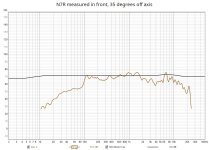 N7R measured in front, 35 degrees off axis.jpg178.2 KB · Views: 99
N7R measured in front, 35 degrees off axis.jpg178.2 KB · Views: 99 -
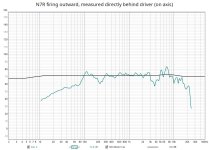 N7R firing outward, measured directly behind driver (on axis).jpg181 KB · Views: 103
N7R firing outward, measured directly behind driver (on axis).jpg181 KB · Views: 103 -
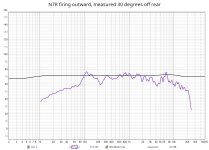 N7R firing outward, measured 30 degrees off rear.jpg180.2 KB · Views: 107
N7R firing outward, measured 30 degrees off rear.jpg180.2 KB · Views: 107 -
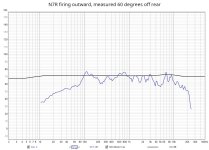 N7R firing outward, measured 60 degrees off rear.jpg179.3 KB · Views: 113
N7R firing outward, measured 60 degrees off rear.jpg179.3 KB · Views: 113 -
 N7R firing outward, measured 45 degrees off rear.jpg180 KB · Views: 100
N7R firing outward, measured 45 degrees off rear.jpg180 KB · Views: 100 -
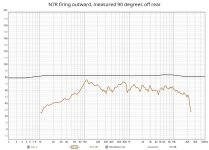 N7R firing outward, measured 90 degrees off rear.jpg179 KB · Views: 105
N7R firing outward, measured 90 degrees off rear.jpg179 KB · Views: 105 -
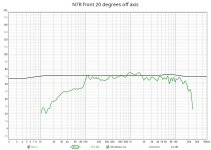 N7R front 20 degrees off axis.jpg172.7 KB · Views: 104
N7R front 20 degrees off axis.jpg172.7 KB · Views: 104 -
 N7R front, on axis.jpg150.3 KB · Views: 100
N7R front, on axis.jpg150.3 KB · Views: 100
dcgold, thank you, for producing the many above plots which, essentially, appear to indicate significant high-frequency response does exist horizontally (at 90 degrees off-axis) around the back-side of an inverted-mounted driver. Interesting.
Last edited:
First SB12PAC
Then SB65WBAC25
I would caution against using the rear of the driver as the main radiator. When I've measured it the rear response is not as clean as the front response, there is significantly higher distortion.
Here is front vs back of the SB12PAC.
Then ND105.
Then SB65WBAC25
I would caution against using the rear of the driver as the main radiator. When I've measured it the rear response is not as clean as the front response, there is significantly higher distortion.
Here is front vs back of the SB12PAC.
Then ND105.
Attachments
-
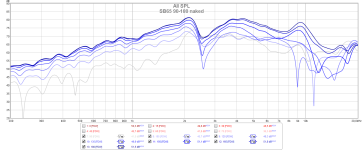 SB65 90-180 naked.png63.4 KB · Views: 104
SB65 90-180 naked.png63.4 KB · Views: 104 -
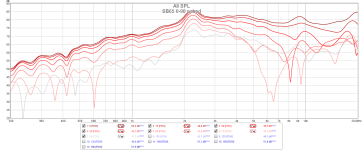 SB65 0-90 naked.png66.1 KB · Views: 107
SB65 0-90 naked.png66.1 KB · Views: 107 -
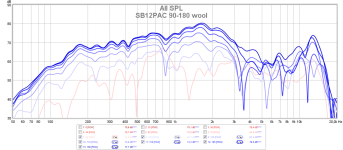 SB12PAC 90-180 wool.png125 KB · Views: 112
SB12PAC 90-180 wool.png125 KB · Views: 112 -
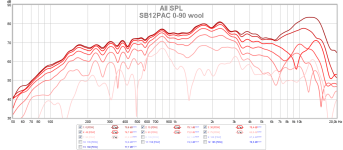 SB12PAC 0-90 wool.png116.7 KB · Views: 109
SB12PAC 0-90 wool.png116.7 KB · Views: 109 -
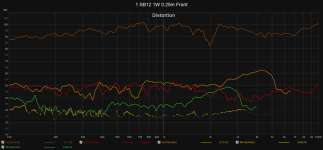 1 SB12 1W 0.25m Front.png50 KB · Views: 111
1 SB12 1W 0.25m Front.png50 KB · Views: 111 -
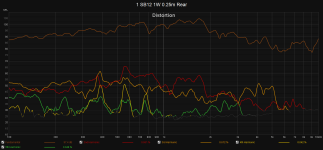 1 SB12 1W 0.25m Rear.png56.4 KB · Views: 89
1 SB12 1W 0.25m Rear.png56.4 KB · Views: 89 -
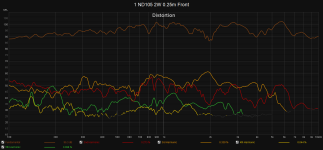 1 ND105 2W 0.25m Front.png55.5 KB · Views: 91
1 ND105 2W 0.25m Front.png55.5 KB · Views: 91 -
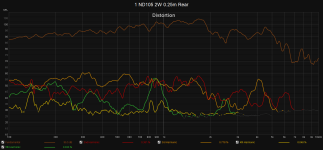 1 ND105 2W 0.25m Rear.png57 KB · Views: 102
1 ND105 2W 0.25m Rear.png57 KB · Views: 102
Just looking at the pictures of a BAYZ Audio speaker…it appears to use to inverted larger SB Satori drivers with the 6.5 inch drivers frame and magnetic assembly used on the back. The crossover is reported to be 2k. I image a lot of the character of this design is the pulsating(?) tweeter and equalization if any.
I have heard that Bays Audio speaker you mentioned before and I thought it sounded like crap. Don't copy it!
That’s true, as your plots, and CharlieLaub’s plot in comment #2, indicate.I would caution against using the rear of the driver as the main radiator. When I've measured it the rear response is not as clean as the front response, there is significantly higher distortion.
The reason we were exploring the response at the rear of drivers was in an attempt verify, or falsify, the presumption of Ohm Acoustics, and of many onmi diy builders that a normal woofer mounted-vertically and inverted, will, indeed, radiate horizontally 360 degrees across the full bandwidth of the driver. In other words, as a Walsh driver does.
Sorry to sy, but IMO OhmWalsh description of how they work is makebelieve bulls#t . Seems like they have no idea or measurements of how soundwaves of different wavelength radiate. The rearside of a cone driver has spider and motor too making major interferences, adding distortion by that way.
A more sane approach comes from Bang&Olufsen. Even there each radiator has quite narrow band of clean operation.
https://www.bang-olufsen.com/en/int/speakers/beosound-2-ferrari-edition
https://www.beoworld.org/prod_details.asp?pid=800

A more sane approach comes from Bang&Olufsen. Even there each radiator has quite narrow band of clean operation.
https://www.bang-olufsen.com/en/int/speakers/beosound-2-ferrari-edition
https://www.beoworld.org/prod_details.asp?pid=800
Juhazi, that is my feeling as well.
In that Ohm patent, they specify crossing over the inverted woofer to a super-tweeter @ 8KHz. While the plots made by the contributors in our thread do appear to indicate significant radial output at that frequency, as you correctly allude, that output is very jagged in response. Indicating reflections, cavity resonances and diffraction effects from the basket, spider and motor.
The relevant Ohm Acoustics’ patent: https://patents.google.com/patent/US4440259A/en
To be clear, a Walsh driver is different, and covered under a different patent: https://patents.google.com/patent/US3424873A/en
In that Ohm patent, they specify crossing over the inverted woofer to a super-tweeter @ 8KHz. While the plots made by the contributors in our thread do appear to indicate significant radial output at that frequency, as you correctly allude, that output is very jagged in response. Indicating reflections, cavity resonances and diffraction effects from the basket, spider and motor.
The relevant Ohm Acoustics’ patent: https://patents.google.com/patent/US4440259A/en
To be clear, a Walsh driver is different, and covered under a different patent: https://patents.google.com/patent/US3424873A/en
Last edited:
FYI - Regarding the proprietary Bayz Audio psuedo-planar tweeter. It resembles a multi-sided, so-called, ‘Rubanoid’ tweeter.Just looking at the pictures of a BAYZ Audio... The crossover is reported to be 2k. I image a lot of the character of this design is the pulsating(?) tweeter and equalization if any.
Here’s the BAYZ tweeter patent: https://patents.google.com/patent/US9088849B2/en
FYI - Regarding the proprietary Bayz Audio psuedo-planar tweeter. It resembles a multi-sided, so-called, ‘Rubanoid’ tweeter.
Here’s the BAYZ tweeter patent: https://patents.google.com/patent/US9088849B2/en
Interesting. I had assumed they were using a version of what Gallo used for their tweeter.
If anyone has been curious, here are front and rear photos of the inverted woofer mounting - with a dome tweeter perched on top of the magnet - used in Ohm’s affordable non-Walsh driver speakers. It definitely appears to be a typical, inexpensive cone woofer, and not a costly Walsh driver.


- Home
- Loudspeakers
- Planars & Exotics
- Inverted mounted driver polar-response